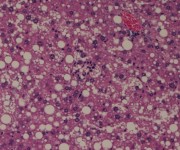01/08/2016
JUVENILE OBESITY: PROGRESSION OF LIVER DISEASES FASTER IN THE PEDIATRIC AGE AND IN MALES
IT IS THE RESULT OF A STUDY PUBLISHED ON PLOS ONE BY RESEARCHERS OF THE ITALIAN LIVER FOUNDATION
Il Parco
Wrong nutrition is accused to be the cause of juvenile obesity and the chronic diseases that come with it. In particular, the pathological implications of juvenile/paediatric obesity (metabolic syndrome) on the liver are the focus of a research published in the journal Plos One, which has investigated what happens to the liver when in the paediatric age the prevailing diet is based on junk food and sugars.
The study builds on a mouse model developed by the Italian Liver Foundation (FIF) in the laboratories of AREA Science Park. The model reproduces the onset of the juvenile metabolic syndrome, with its implications on the liver, the cells of which, at some point, are no longer able to dispose of the excess fat. The result is the emergence of the non-alcoholic fatty liver disease (NAFLD) and non-alcoholic steatohepatitis (NASH). Indeed, also a recent report published by WHO Europe draws attention to the need of improving maternal nutrition and that of the first period of a child’s life with the aim of decreasing the risk of chronic diseases, including obesity.
What the FIF researchers have found out is that in the paediatric age the progression of the disease is faster, with a generally more serious prognosis than in adults. They have also identified a gender difference in the development speed of the disease, which sees in male mice a more rapid progression at the early stage, also if the final damage is the same for males and females. More in detail, the study consisted in feeding 6 mice with a high-fat diet and the addition of fructose in water, which began immediately after weaning (equivalent to 3 human years) and continued for 16 weeks, until adulthood (equivalent to 30 human years).
The result? 100% of the subjects of both sexes developed fatty liver in four weeks and a certain degree of fibrosis (“scarring”) in eight weeks, with 86% of males and 15% of females with stage 2 fibrosis (considered the “point of no return”) in sixteen weeks. Despite the fact that both groups of animals showed a similar final liver damage, alterations in glucose homoeostasis, dyslipidemia, hepatomegaly and obese phenotype, translated into an increase in hepatic inflammation, in males were evident from the start. On the contrary, these alterations were evident in females only at the end of the experiment (with the exception of insulin resistance and liver inflammation, which females never developed). It was also noted that only females showed an altered hepatic redox state (reduction and oxidation).
“Considering that juvenile obesity is exploding in Italy too and that damage to the liver from the metabolic syndrome over the next few years will become the leading cause of liver transplantation, the model will be an excellent platform for studying the mechanisms that lead to that damage, understanding the male/female differences and testing new drugs and diagnostic approaches”, comments Professor Claudio Tiribelli, director of the Italian Liver Foundation and one of the authors of the paper.
TITLE OF THE PAPER: “AN ANIMAL MODEL FOR THE JUVENILE NON-ALCOHOLIC FATTY LIVER DISEASE AND NON-ALCOHOLIC STEATOHEPATITIS”. PLOSONE, HTTP://DX.DOI.ORG/10.1371/JOURNAL.PONE.0158817
AUTHORS: VERONICA MARIN, NATALIA ROSSO, MATTEO DAL BEN, ALAN RASENI, MANUELA BOSCHELLE, CRISTINA DEGRASSI, IVANA NEMECKOVA, PETR NACHTIGAL, CLAUDIO AVELLINI, CLAUDIO TIRIBELLI, SILVIA GAZZIN